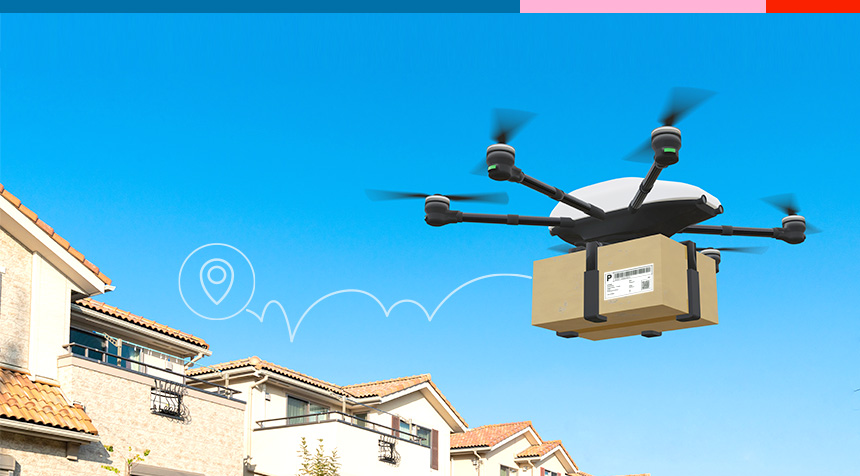It was just over five years ago that 7-Eleven delivered a chicken sandwich, donuts, coffee, candy, and Slurpees to a house in suburban Reno, NV marking the first autonomous drone retail delivery in history.
Since then, significant progress has been made on the technological, operational and regulatory fronts with major retailers, technology companies, logistics providers and drone developers making significant investments in drone delivery operations and running pilots with various partners and varying degrees of success.
Notwithstanding the progress made in bringing initial drone delivery services to a limited number of consumers, there are regulatory issues that must be addressed. With airplanes, helicopters and an ever-increasing number of drones filling the sky, regulatory authorities such as the US Federal Aviation Authority sought to limit drone activity by granting certification only to line-of-site operations. This is of course a non-starter for retail delivery.
The past few years, however, have seen progress made on this front with regulators cooperating with retailers and drone delivery providers to change these rules in an effort to enable the growth of autonomous drone delivery.
While this is all good news for drone delivery, one should realize that most of the actual deliveries have been done under heavily monitored conditions on a very limited scale. Just thinking about the possibilities of bad weather, drone accidents and technical malfunctions when there are thousands of drones in the air, makes it pretty clear that there is still a way to go before drone delivery pops up as an option at checkout.
Important Drone Initiatives Get off the Ground
After a decade of experimentation, trials and partnerships, leading retailers are finally launching drone delivery services for real – albeit on a limited basis for now – as last mile delivery inevitably heads toward mass adoption of drones and other autonomous delivery technologies.
Amazon
Since founder and former CEO of Amazon, Jeff Bezos, first announced his vision of Amazon’s Prime Air Delivery Service back in 2013, the company has been investing significant resources into drone delivery. As a pure online retailer without a brick-and-mortar operation, this makes a lot of sense considering that last mile delivery makes up 53% of all shipping costs. According to Amazon Prime Air, after years of work by scientists, aerospace professionals and engineers, customers in rural Lockeford, CA now have an option of drone delivery. It’s also important to note that rural neighborhoods are the sweet spot of drone delivery.
Walmart
As a leading retailer with almost 5000 physical locations across the US, Walmart is not an online entity which might be why they invested in last mile drone delivery provider DroneUp. The Walmart-DroneUp partnership is offering drone delivery in Arizona, Arkansas, Florida, Texas, Utah and Virginia, with the goal of delivering online orders to their customers in one hour or less. Walmart’s advantage is the number of neighborhood stores it can use as the starting point for local drone delivery. The retailer claims that it is already in the process of setting up drone delivery in nearly 40 stores which could potentially serve 4 million homes.
Drone delivery company Wing was created by Google and, as can be expected from a leading technology developer, has added advanced algorithms to provide complex route management and self-loading features in order to attain massive scale. Wing is currently available in 10 global locations, including Dallas, TX in the US, and claims to have made over 100,000 drone deliveries since the company’s inception.
Main Factors Affecting Adoption of Drone Delivery
With leading companies finally launching drone delivery services and regulatory bodies making efforts to provide certification that allow the industry to grow, there are still both positive and negative aspects to drone delivery that will affect the pace of mass adoption.
Positives
There are many positive reasons for retailers and consumers to prefer drone delivery which are fueling the growth of the industry today:
- Faster delivery speeds with no limitations due to road conditions or traffic
- Greater efficiency with no driver downtime in the warehouse or loading dock
- Reduces expenses with a lower cost per delivery, smaller fleets and fewer drivers
- Increased accessibility with faster delivery to rural and remote locations
- Better for the environment than gasoline powered delivery trucks
Negatives
For every good reason to push the drone movement forward, there seems to be an obstacle to overcome before this delivery method becomes commonplace:
- Safety issues regarding interference with other aircraft
- Liability for damage caused by a drone crash or technical malfunction
- Invasion of privacy when using cameras to film customers during delivery
- Intrusive for residential neighborhoods due to loud incessant buzzing
- Capacity issues as most drones cannot deliver packages over 5 kilo/10 lbs
At the end of the day, it’s pretty clear that the positive reasons will push the growth of drone delivery while the negative aspects will be remedied over time by advanced technology, improved operations and better regulations.
Integration and Management of Drone Technology
Since the concept of drone delivery was first introduced a decade ago, there have been significant advancements in both delivery and drone technologies. With various players in the ecosystem, including pure online retailers, brick-and-mortar retailers, technology companies, delivery service providers and drone developers, all participating in various pilot projects, the technology is now at the tipping point of mass adoption.
What were once experimental trials are now giving way to the launch of actual drone delivery services in limited regions. If the obstacles cited above can be addressed including logistical, technological, regulatory and environmental challenges, then there is a good chance we will soon see drone delivery starting in rural areas and then spreading to more densely populated urban centers as the technology and consumer acceptance evolves.
Perhaps drone delivery will be knocking on our doorstep sooner than we think.



